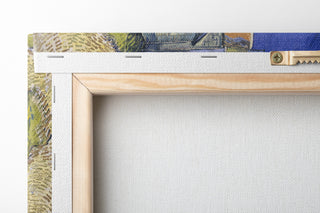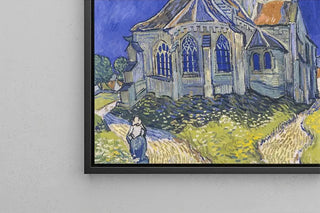Art print Monument of Willem Eygaert in the New Church of Amsterdam - Johan Adolph Rust


View from behind

Frame (optional)
A sculptural memory revealed: Monument of Willem Eygaert in the New Church of Amsterdam, highlighted by Johan Adolph Rust
The composition presents a solemn balance where stone and religious ornamentation dialogue with the ambient light. Johan Adolph Rust captures the textures of marble and the play of shadows that define the monument's reliefs, using a sober palette punctuated with warm tones to emphasize architectural depth. The overall effect is both contemplative and majestic, inviting the gaze to follow the vertical lines and carved details. This pictorial reading restores the sacred atmosphere of the New Church while highlighting the dignity of the commemorated figure.
Johan Adolph Rust, master of historical realism
Rust is in the tradition of 19th-century realist painters who favored documentary fidelity and the highlighting of historical and religious subjects. Influenced by the interest in heritage and building interiors, he often worked on commissions or architectural studies, seeking to render the authenticity of materials and the atmosphere of places. His approach combines descriptive rigor and sensitivity to light effects, making his works precious witnesses of heritage. The art print of the Monument of Willem Eygaert in the New Church of Amsterdam fits into this heritage, offering a perspective both informative and aesthetic.
A decorative acquisition with multiple assets
This art print of the Monument of Willem Eygaert in the New Church of Amsterdam fits different interiors: living room, office, entrance hall, or library, where it brings a note of history and refinement. As a painting Monument of Willem Eygaert in the New Church of Amsterdam, it offers a visual presence that structures the space without overloading it. Offered in high fidelity, the canvas Monument of Willem Eygaert in the New Church of Amsterdam respects the original colors and details for a durable and elegant reproduction. Chosen for its quality and narrative character, it will appeal to lovers of historical art and enthusiasts of sacred architecture.

Matte finish

View from behind

Frame (optional)
A sculptural memory revealed: Monument of Willem Eygaert in the New Church of Amsterdam, highlighted by Johan Adolph Rust
The composition presents a solemn balance where stone and religious ornamentation dialogue with the ambient light. Johan Adolph Rust captures the textures of marble and the play of shadows that define the monument's reliefs, using a sober palette punctuated with warm tones to emphasize architectural depth. The overall effect is both contemplative and majestic, inviting the gaze to follow the vertical lines and carved details. This pictorial reading restores the sacred atmosphere of the New Church while highlighting the dignity of the commemorated figure.
Johan Adolph Rust, master of historical realism
Rust is in the tradition of 19th-century realist painters who favored documentary fidelity and the highlighting of historical and religious subjects. Influenced by the interest in heritage and building interiors, he often worked on commissions or architectural studies, seeking to render the authenticity of materials and the atmosphere of places. His approach combines descriptive rigor and sensitivity to light effects, making his works precious witnesses of heritage. The art print of the Monument of Willem Eygaert in the New Church of Amsterdam fits into this heritage, offering a perspective both informative and aesthetic.
A decorative acquisition with multiple assets
This art print of the Monument of Willem Eygaert in the New Church of Amsterdam fits different interiors: living room, office, entrance hall, or library, where it brings a note of history and refinement. As a painting Monument of Willem Eygaert in the New Church of Amsterdam, it offers a visual presence that structures the space without overloading it. Offered in high fidelity, the canvas Monument of Willem Eygaert in the New Church of Amsterdam respects the original colors and details for a durable and elegant reproduction. Chosen for its quality and narrative character, it will appeal to lovers of historical art and enthusiasts of sacred architecture.






